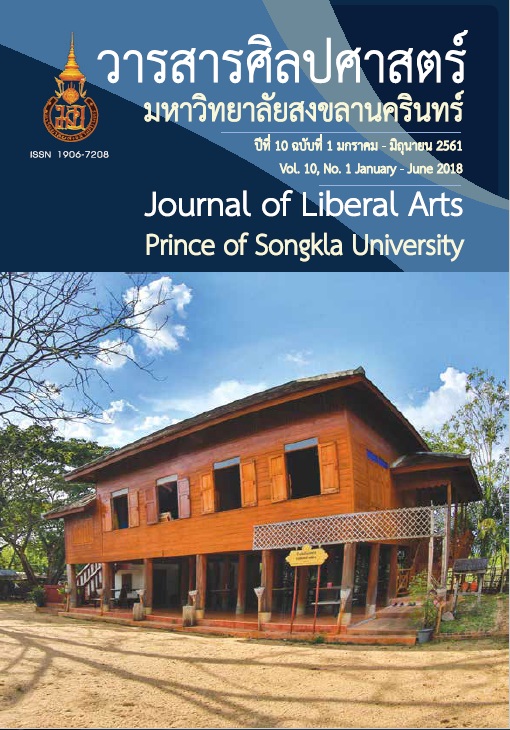A Study of relationships between medical tourism potential and behavioral intentions of medical tourists in Thailand
Keywords:
Potential, medical tourism, behavioral intentionsAbstract
This study aims to find out the levels of potential related to medical tourism industry and the levels of behavioral intentions of medical tourists in Thailand, and to find out the relationships between the potential of medical tourism and the behavioral intentions of medical tourists in Thailand. The research tool was a questionnaire consisting of 2 sections: the potential of medical tourism industry, and the behavioral intentions. The reliability of the questionnaire was .797, with a 5-level rating scale arranged in ascending order. The subjects were 400 foreigners travelling to obtain medical services in Thailand. The number of questionnaires returned was 374 copies or 93.50 percent. The data collected were analyzed with descriptive statistics: means and standard deviation to determine the levels of variables, and inferential statistics: Pearson correlation analysis to examine the relationships between variables.
The study found that overall, medical tourism potential of Thailand and behavioral intentions were both at a high level.
Three variables had a very high level of positive relationship with the behavioral intentions of medical tourists: 1) medical service quality,
2) human resources for services, and 3) natural resources and cultures for tourism. Four variables had a high level of positive relationship with the behavioral intentions of medical tourists: 1) infrastructure and communications, 2) transportation, 3) price, and 4) safety and security system. The only variable with a moderate level of positive relationship with the behavioral intentions was promotion and support of medical tourism. All variables had statistical significance at the level of .01
References
Heung, V. C. S., Kucukusta, D. and Song, H. (2010). A conceptual model of medical tourism: Implication for future research. Journal of Travel and Tourism Marketing. 27(3), 236-251.
JCI. (2015). JCI-accredited organizations. Retrieved from: www.jointcom
missioninternational.org/about-jci/jci-accreditedorganizations/?c=
Thailand&F_All=y.
Kasikorn Research Center. (2012). Health tourism business, Thailand opportunity in penetrating ASEAN market. Retrieved from: www.ksmecare.com/Article/82/28465. [In Thai]
. (2016). Thailand foreign tourism market in 2016 is still growing and emphasizing quality markets for marketing sustainable income. Retrieved from: www.thaichamber.org/userfiles/file/kbank(6).pdf. [In Thai]
Kantawongwan, K., Untong, A., & Khosat, M. (2016). Competitive abilities of Thailand health tourism industry. Social Research Institute. Chiang Mai University, Chiang Mai. [In Thai]
Khoonthong, L. (2007). An approach of planning for medical tourism development in Phuket Province. (Master’s thesis). Graduate School, Srinakharinwirot University, Bangkok. [In Thai]
Kotler, P. (2004). Thailand’s nation branding: A study of Thai nation-brand equity and capabilities. Retrieved from: www.diva- portal.org/smash/get/ diva2:126597/FULLTEXT01.pdf.
Office of the Public Sector Development Commission. (2015). Ministry of Public Health and Ministry of and Sports develop and support Thailand to the center of Health Tourism. Retrieved from: http://203.157.7.46/display_ news.jsp?id=N00000002484. [In Thai]
Phisayaboot, S. (2007). Developing research instruments and evaluating questionnaire. Bangkok: Vittayapat. [In Thai]
Sahamathapat, N. (2013). International health tourism hub. Retrieved from: www.ocsc.go.th/ocsc/th/files/Executive_Meeting/Meeting256
/3g_medicalhub.pdf. [In Thai]
Siriphattrasophon, S., & Thanaphikhuptanon, P. (2011). Relationship between perceived service quality, patient satisfaction and loyalty: A case of private hospital in Bangkok. Khon Kaen University Research Journal, 10(2), 160-172. [In Thai]
Skyscanner (Thailand). (2015). Thailand was ranked 1 of 10 destinations with highest increase in number of searchers. Retrieved from www.skyscanner.co.th. [In Thai]
Songsraboon, R. (2014). Perceived service quality and factors affecting word of mouth communication of private hospitals. Panyapiwat Journal, 5(2), 16-29. [In Thai]
Srisukho, C. (2012). Medical tourism industry. Department of Industrial Promotion Journal, 54(1), 32-33. [In Thai]
Sukho, N. (2015). The market analysis of medical tourism in Thailand. Suthiparithat Journal, 29(89), 1-15. [In Thai]
Supasririkijjarean, J. (2015). The behavior in medical service of foreign patients. Siam Academic Review, 16(1), 31-48. [In Thai]
Thansettakij. (2016). Thailand tourism hit a record 2.23 trillion in 2015. Retrieved from www.thansettakij.com/2016/01/08/25115. [In Thai]
The Office of SMEs Promotion. (2013). Tourism capital of Asia. Retrieved from www.sme.go.th. [In Thai]
World Economic Forum. (2013). the travel and tourism competitiveness. Retrieved from www3.weforum.org/docs/WEF._GlobalCompetitive
nessReport_2013-14.pdf. [In Thai]
Yamane, T. (1973). Statistics: An introductory analysis. (3rded.). New York. Harper and Row Publications.
Zeithaml, V. A., Berry, L.L., & Parasuraman, A. (1996). The behavioral consequences of service quality. Journal of Marketing. 60(2), 31-46.
Downloads
Published
How to Cite
Issue
Section
License
The authors retain the copyright to their article but the Journal of Liberal Arts, Prince of Songkla University reserves the exclusive rights to first publication.






